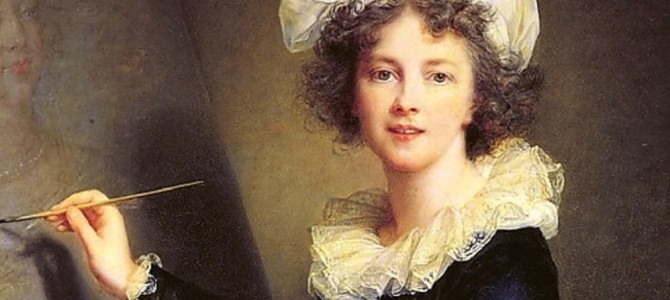
Elizabeth Vigée Le Brun (1755-1842) is best known today as the favorite court painter of Queen Marie Antoinette, whom she painted on no less than 30 occasions, more than any other artist. Her skills as a portraitist brought her to the attention of the ancien régime as a young artist, but during the course of her long career Vigée Le Brun painted dozens of portraits of lords and ladies from all over Europe.
She not only survived the French Revolution, exile, divorce, the Napoleonic wars, and the upheaval of European society, but she lived to write about it, in lengthy and highly interesting memoirs. On the surface, then, she seems just the right sort of artist to be the subject of a major exhibition.
“Vigée Le Brun: Woman Painter In Revolutionary France” opened at The Metropolitan Museum of Art on February 15, as a somewhat pared-down version of a more comprehensive show that appeared at the Grand Palais in Paris between September 2015 and January of this year. Surprisingly, it was the first major retrospective of her work to appear in her native France. Given the perennial popularity of her most famous patroness in film, literature, and fashion, it seems unfathomable that no one until now has taken the time to survey the work of an artist who was so important in forming the way that we picture Marie Antoinette.
Portraits of a Stiff, Bourbon Barbie
Indeed, The Met show contains a number of Vigée Le Brun’s portraits of Marie Antoinette, including the very first the artist painted of the queen. Upon entering the gallery the visitor immediately confronts Vigée Le Brun’s massive canvas, “Marie Antoinette in Court Dress,” (1778) one of many iconic images she would create of the ill-fated monarch. The piece was originally commissioned by the queen’s mother, the Empress Maria Theresa, back home in Vienna, so she could see what her daughter now looked like. That fact gives some element of poignancy to what is otherwise a flashy, stage-managed production piece.

The technical passages of the queen’s white satin gown in the painting are beautifully rendered, and are particularly noteworthy when considering that Vigée Le Brun was only 23 years old when she painted this picture. The piece is lavishly regal, with the royal crown placed on a pillow upholstered in French fleur de lis, and a bust of Louis XVI overlooking the scene. The figure of the queen herself, however, is somewhat unremarkable, and a bit like a wax fashion doll: the informal Habsburg princess is showing her mother how she has grown up to become a stiff, Bourbon Barbie.
Perhaps the image of Marie Antoinette for which Vigée Le Brun is most famous is “Marie Antoinette and Her Children” (1785), and fortunately it was permitted to leave Versailles for this exhibition. It is a masterpiece of court propaganda, although it only blunted the attacks on the increasingly unpopular queen for a time. If you only ever see one painting by Vigée Le Brun, this is the one you want to see, and spend time looking at.

Rather than appearing as a fashion plate, Marie Antoinette is here shown as the mother of three small children, all of whom dote on her. The empty cradle is not for the children surrounding her, but rather is symbolic of the queen’s youngest child, who had just died. It was an attempt, albeit an ultimately unsuccessful one, to try to humanize the monarchy, so that those who saw this painting could sympathize with the queen, and consider the fact that she, too, had suffered in life. Yet however sympathetic one may feel toward the family, one cannot help but wonder if creating such an image crossed a dividing line.
Neither a Mere Woman Nor Mostly in France
This line is also a problem with the show itself, as the title of the exhibition shows: “Woman Painter in Revolutionary France.” As an initial matter, while all ladies are women, not all women are ladies (see e.g., Lena Dunham). Had Vigée Le Brun not been a lady, and one with decidedly monarchist sympathies, she would not have been accepted as a regular guest in the homes of the aristocracy.
The informality of “The Duchesse de Polignac In A Straw Hat” (1782) for example, would never have been entrusted to a “woman painter” with whom the very glamorous and fashionable duchess could not relate, on a very real level. Vigée Le Brun hated the caked-on, powdered makeup of the age, and encouraged her sitters, as in this portrait, to be more naturally feminine. To characterize her as a “woman painter” given this context is to attempt to classify her as being akin to an early bra-burner which, politically at least, she most certainly was not.

Moreover, Vigée Le Brun was not exactly “in Revolutionary France,” at least not for very long. The artist and her daughter fled France in 1789, shortly after the revolution began; Vigée Le Brun did not return home for nearly two decades. Thus, there are no portraits of French revolutionaries in this exhibition, only of their victims. Indeed, half of the paintings in the show are of non-French persons. The exiled artist had to earn her living in Italy, Germany, Russia, and England.
One comes away with the impression that the organizers of the exhibition must be indifferent not only to the horrors of the revolution, but to what Vigée Le Brun herself must have suffered personally as a result of it. After all, not only did she have to flee for her life, but many of her friends and patrons were murdered. Perhaps the decision was made that, because so many of the works in the show are the property of the French government, and are rarely allowed to leave France, it would be best to sweep the Reign of Terror under the rug, or at least try to downplay it, as the French somehow find the gall to do every Bastille Day.
Elizabeth Vigée Le Brun Best Paints Women as Themselves
A distinct dumbing down seems to have taken hold of the collective ethos of The Met of late. From its disastrously bad new logo—excoriated to perfection recently by Justin Davidson in Vulture—to its poorly described exhibitions, it is difficult to understand the identity crisis that one of America’s most prestigious institutions is undergoing.
When the placard accompanying a Vigée Le Brun portrait of the “Barrone de Crussol Florensac” (1785), depicted as reading or singing from a clearly legible piece of sheet music, does not even bother to mention anything about the music shown or its significance in the painting, one is left wondering what, exactly, The Met believes its responsibility as an educational institution to be.

Having considered these points, however, the truly important question in this exhibition is: Was Vigée Le Brun a great artist? I think the answer must be: no. Although much of her work is charming, and occasionally even splendid, when she drifted away from portraiture she drifted away from her skills as a painter. The single landscape painting in the exhibition, “Festival of the Shepherds at Unspunnen” (1808-9) is an interesting work, with an amusing “Where’s Waldo?” aspect to it in which the viewer can track down the figure of the artist herself, but it is not a great painting. Similarly, the handful of mythological scenes in the show are populated by rather awkward, unbelievable gods.

Where she excelled, particularly in her self-portraits and in feminine portraiture in general, Vigée Le Brun could turn out truly beautiful, even lively images. The pleasure of the exhibition, as one moves through it, lies in noting how she became more confident and relaxed in her portrayals of her sitters as she gained in experience.
It is hard to believe that the artist who painted the Marie Antoinette mannequin of 1778 is the same artist who painted the arresting, flirtatious portrait of “Isabella Teotochi Marini” (1792) in the same exhibition. With her flashing eyes and daring décolletage, one gets the impression that Isabella was probably the life of the party. It is in these images, of women being themselves, that Vigée Le Brun created her best work.

At the conclusion of the exhibition, one sees the portrait of “Count Emmanuel Nikolayevich Tolstoy” (1823). “He looks like your avatar,” commented the friend who accompanied me to the show. Without meaning to do so, I think he rather neatly summed up the artist’s work.

Elizabeth Vigée Le Brun created attractive, engaging images that were designed to tell the viewer what the sitter wanted them to know. In other words, she was an adept creator of avatars. Yet while her artistic skills in creating these images were remarkable, with a handful of exceptions she never really got the knack of how to portray someone who was not only beautiful on the outside, but also on the inside. There is more beauty in a Velázquez portrait of an old peasant woman frying eggs, or a Goya sketch of a crippled beggar, than in most of the pretty, but often shallow paintings in this exhibition.
“Vigée Le Brun: Woman Painter In Revolutionary France” is at The Metropolitan Museum of Art through May 15.









